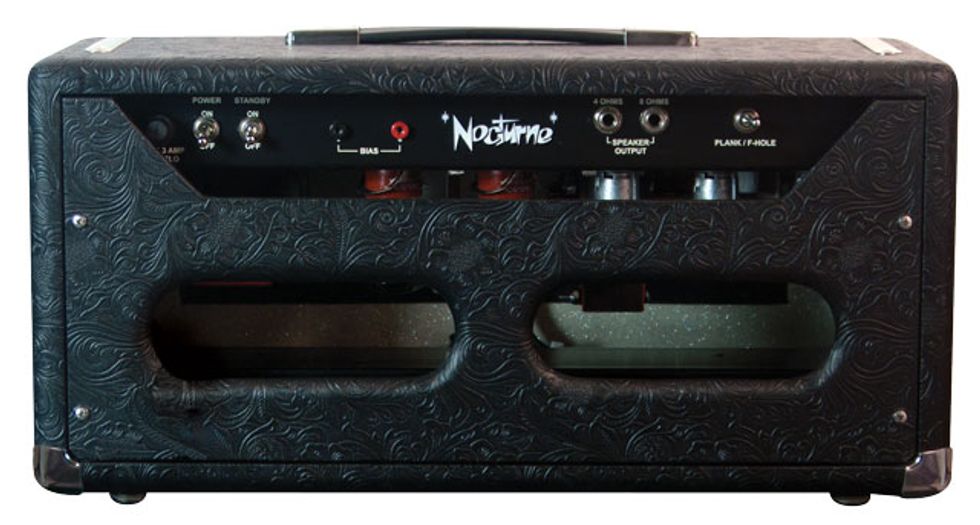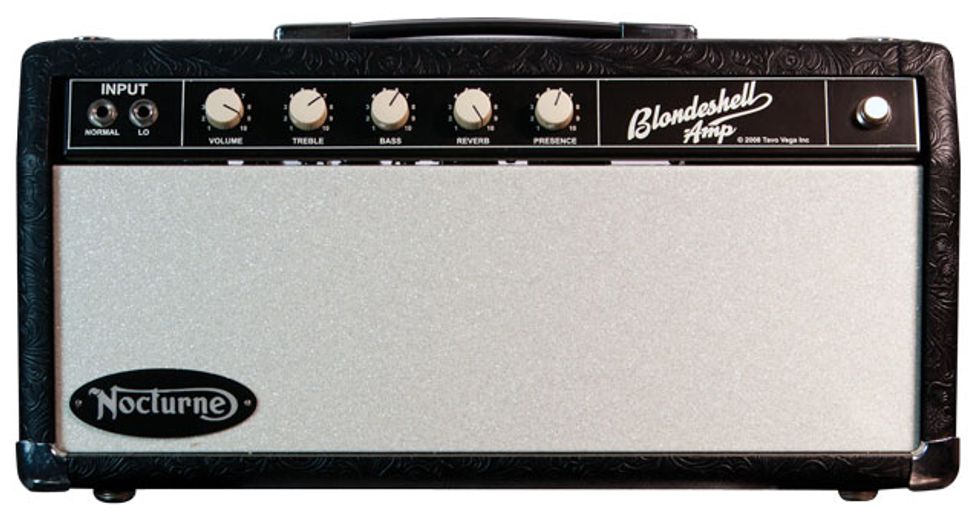Considering how many players have been influenced by rockabilly/swingjazz icon Brian Setzer and his twangtastic Gretsch-through-a-Bassman rig over the last 30 years, it’s shocking how few companies are making clones of the Fender 6G6-B version he favors—especially when you consider how rare it is (the blonde heads he uses were only in production from 1962–64). Never mind how many amp manufacturers take huge cues from so many other vintage Fender designs.
Run by Tavo Vega out of his shop in Southern California, Nocturne Amplification is one of the few outfits today specializing in 6G6-B Bassman-based designs. While the company also offers other products intended to help you replicate key aspects of the Stray Cats frontman’s tone (including the Dyno Brain and Atomic Brain pedals, which mimic the tonal characteristics imparted by a Roland RE-301 Space Echo’s preamp section), the Blondeshell represents the pinnacle of Vega’s Setzer love. Based on the normal channel of a 6G6-B Bassman, it aims to capture the coveted amp tones on Brian Setzer Orchestra albums. For those who don’t have a collection of Space Echo units, it also includes built-in spring reverb for ambience (period-correct 6G6-Bs don’t have it).
Interestingly, the Blondeshell (and all other Nocturne products, for that matter) are built through co-op partnerships Vega has established with other craftsmen throughout the US. The amp’s custom aluminum chassis and fiberglass-epoxy eyelet circuit boards—which use Mercury Magnetics transformers, Sprague Orange Drop coupling capacitors, and Mallory 150-series caps—are built by Ron Williams, and then Vega assembles the final product in a Mojo Musical Supply cab.
Behind the Sparkle
The 50-watt Blondeshell runs of a pair of
Tung-Sol 5881 power tubes, and it uses two
Ruby Tubes 12AX7s—one each for the preamp
and phase inverter—as well as a Tung-
Sol 12AX7, which drives the long-spring
MOD reverb tank. The front panel includes
normal and lo inputs, five knobs—volume,
treble, bass, reverb, and presence—and a
white jeweled power indicator. Around back,
notable features include super-handy bias
points for the power section, 8 Ω and 4 Ω
speaker outs, and a Plank/F-Hole voicing
toggle. More on that later.
One of the biggest differences between pre-6G6-B Bassman circuits—including ’50s tweed models and the first blonde 6G6 model produced from ’61-’62—and Setzer’s preferred circuit is that the latter has a solid-state rectifier rather than the 5UR4G used throughout the ’50s, and the GZ34 used in the first blonde heads. The Nocturne is faithful to that vintage spec, which yields a more robust tone with less squishiness in the overall response.
Our review unit arrived with a rebelliously cool, if somewhat puzzling, mix of aesthetic touches: The blackface-style chassis is secured to a housing covered in Westernthemed, faux-tooled vinyl, while the front panel is covered in silver-sparkle vinyl, and the plastic nameplate features a font that seems more gothic or metal than retrobilly. That said, the craftsmanship was solid and well executed, although the chassis didn’t quite fit the cabinet—under the control panel, you could see through to the back of the cab, and there were 3/8" and 1/8" gaps on the left and right sides, respectively.

Dropping the Bombshells
To test the Blondeshell, I paired it with a
closed-back Bogner 2x12 cab loaded with
Celestion Vintage 30s (Setzer’s speaker of
choice), and plugged in a variety of guitars—a Gretsch Electromatic G5120 loaded with
TV Jones Classics, a Squier ’50s Classic
Vibe Tele with a Fender Custom Shop Jim
Campilongo bridge pickup, a mahogany
Hahn T-style guitar, and a Schecter Ultra III
with Duncan-designed mini-humbuckers.
As you probably figured out, the rearpanel Plank/F-Hole toggle is meant to accommodate solidbodies in the former position, and semi-hollow or hollowbodied guitars in the latter. Naturally, I chose F-Hole and tried out the Gretsch first—t’would be blasphemous otherwise.
One of the first things I noticed was that, until you get the Blondeshell’s volume up past 9, the amp has less oomph than its 50-watt rating might imply. The tones felt anemic and somewhat one-dimensional when the volume wasn’t up high. For that reason, no matter which guitar I used with the Nocturne, I found that the best variety of tones was available with the volume pretty much cranked.
While the treble, bass, and presence knobs yield a lot of different tones, it was slightly difficult to find the sweet spot. I eventually settled on 7.5, 6.5, and 6, respectively (setting treble or presence any higher than that really thinned out the sound, sometimes painfully so). What about the reverb, you ask? I cranked it! (What can I say, I’m an ambience addict.) Though the long-spring tank isn’t quite surfable at its highest settings, it sounds really, really good—it’s definitely not on of those that bums you out and makes you wonder why they even bothered to include it.
Dialed in thusly, the Blondeshell came alive with my Gretsch, imbuing the bridge pickup with bristling harmonics, snarling mids, and serious punch. It proved a great combination for an authentic rendition of Setzer’s “Rumble in Brighton.” For Travisor hybrid-picking numbers in the vein of Setzer’s “Let’s Live It Up” or “This Old House,” I engaged both TV Classics, backed the neck volume off about a third, and eased up on my attack to get a glorious blend of sparkle and well-rounded body. Meanwhile, soloing the neck pickup and bringing its volume back up yielded super-fat, harmonically rich tones that could’ve kept me busy writing boogie-rock riffs all night. I was also really impressed when I engaged the Gretsch’s “mud switch” to roll off some high end and boost mids—it instantly inspired slippery, chromatic jazz phrasing.
Ratings
Pros:
Quality parts and overall construction. Very
useful Plank/F-hole voicing switch. Nice range of
rootsy tones. Lovely reverb.
Cons:
Expensive. EQ response needs fine-tuning.
Tones:
Ease of Use:
Build:
Value:
Street:
$2,250
Nocturne
thenocturnebrain.com
Set to plank mode and paired with the Teles, the Nocturne really surprised me, though I suppose it shouldn’t have—after all, they’re the original planks. In many ways, the Teles seemed a better match for the Blondeshell. Their solidbodies yielded more pristine highs and dynamic thump than I could manage with a hollowbody, even with the help of the girthadding F-Hole mode. The results were a lot of fun for everything from Stones-y comping (think “Under My Thumb”) to seething indie rock or alt-country fueled by slamming bridge-pickup tones, and Tom Morello-style riffing with the neck pickup. And riffs and complex chords channeled through the bridge pickup of my D-standard-tuned Schecter sounded downright brawny and tough.
The Verdict
Once you find the Nocturne Blondeshell’s
sweet spot, you soon realize you can use the
amp for just about any rootsy or rocking
style that thrives on grit and girth (the phrase
“cranked vintage Marshall” crossed my mind
a few times), and yet it still cleans up enough
to be used in jazz settings that someone like
John Scofield might approve of. While the
responsiveness of the EQ may be vintage
correct, given how many other ways the amp
diverges from the original Fender recipe, I
would’ve liked to see the controls more finely
tuned to be usable throughout their ranges.
However, considering that it’s fundamentally
based on a 50-year-old amp, the Blondeshell
pumps out a very satisfying array of versatile
sounds—provided you’re adept at getting
those sounds using subtle nuances in technique
and attack.








![Rig Rundown: Russian Circles’ Mike Sullivan [2025]](https://www.premierguitar.com/media-library/youtube.jpg?id=62303631&width=1245&height=700&quality=70&coordinates=0%2C0%2C0%2C0)

















